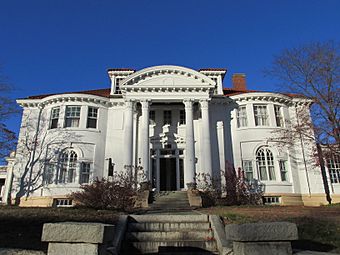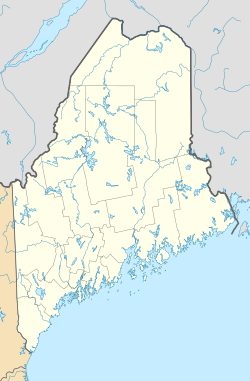Main Street Historic District (Auburn, Maine) facts for kids
Quick facts for kids |
|
|
Main Street Historic District
|
|

|
|
| Location | Auburn, Maine |
|---|---|
| Area | 6 acres (2.4 ha) |
| Architect | Multiple |
| Architectural style | Colonial Revival, Italianate, Queen Anne |
| NRHP reference No. | 89000255 |
| Added to NRHP | April 21, 1989 |
The Main Street Historic District is a special area in Auburn, Maine. It's a collection of fourteen old houses that show how homes were built between 1825 and 1925. This district is located just south of Auburn's main downtown area.
You can find these historic homes along Main Street. The district stretches from Drummond Street past Elm Street. A few houses on Elm and Vine Streets are also part of this important area. In 1989, the Main Street Historic District was added to the National Register of Historic Places. This means it's officially recognized for its historical value.
Contents
Exploring Auburn's Historic Homes
This historic district tells a story about how Auburn grew over time. The houses here show different building styles from the past. Let's take a closer look at some of these interesting homes.
How Auburn Began and Grew
Auburn started as a small settlement near the Androscoggin River. In the late 1800s, it was mainly a camp for log drivers. Unlike its neighbor Lewiston, Auburn wasn't ideal for large textile mills.
However, things began to change. A bridge was built across the river between 1822 and 1823. This helped Auburn develop, especially along what is now Main Street. The oldest house in the district is the Edward Little House at 217 Main Street. It was built in 1826 by Edward Little. He was a very important person who helped Auburn grow from the 1820s to the 1840s.
New Styles: Italianate Homes
More growth came to Auburn with the arrival of the railroad in 1848. In 1854, Auburn was chosen to be the main city for the new Androscoggin County. This made the downtown area even more important. It also led to more homes being built in the historic district.
During the 1850s, several houses were built in the Italianate style. This style often features low-pitched roofs and tall, narrow windows. Examples include the Roak House at 20 Elm Street, built around 1854. Another is the Reynolds-Hasty House at 201 Main Street, built around 1850.
Queen Anne Homes: Fancy Designs
In the late 1800s, many beautiful Queen Anne style houses were built. These homes are known for their detailed and often playful designs. They often have towers, turrets, and decorative porches.
One striking example is the Penley House at 233 Main Street. It was designed by George M. Coombs and built in 1890. This house stands out at the corner of Main and Elm Streets. The A. A. Garcelon House at 223 Main Street is perhaps the most detailed Queen Anne house in Auburn. It was designed by Coburn and Sons and built in 1890 for a local merchant. This house shows off the busy look typical of the Queen Anne style. It has parts that stick out, fancy porches, and even a domed tower. Because of its unique architecture, it was listed separately on the National Register of Historic Places.
Colonial Revival: A Look Back
In the early 1900s, the Colonial Revival style became popular. This style looked back to the simpler, classic designs of early American homes. Several new Colonial Revival houses were built. Many older homes also had Colonial Revival additions or changes made to them.
The Reynolds-Hasty House is an example of an older home that was updated. It received a new porch and large picture windows during this time. The most important house built in this period is the Horatio G. Foss House at 14 Elm Street. It was designed by Gibbs and Pulsifer and built in 1914. This grand home was built for a shoe manufacturer.



